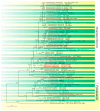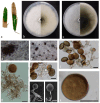Diversity and New Species of Ascomycota from Bamboo in China
- PMID: 39057339
- PMCID: PMC11277934
- DOI: 10.3390/jof10070454
Diversity and New Species of Ascomycota from Bamboo in China
Abstract
Bamboo is an economically important crop that has gained prominence as an alternative to wood to reduce deforestation and ecosystem destruction. Diseases of bamboo that typically occur on leaves and stems can cause significant loss, reducing the quality and yield of the bamboo. However, there are few reports identifying the fungal species diversity and potential pathogens of bamboo. Here, we describe four new species of plant fungi from the leaves of bamboo within Fujian provinces, China. Fungi were isolated from diseased leaves collected within Fujian province and identified based on their morphological characteristics and multilocus phylogenies using nucleotide sequences derived from combined datasets of the intervening 5.8S nrRNA gene (ITS), the 28S large subunit of nuclear ribosomal RNA gene (LSU), the large subunit of RNA polymerase I (rpb1), the translation elongation factor 1-α gene (tef1-α), and the partial beta-tubulin gene (tub2). These analyses helped reveal and clarify taxonomic relationships in the family Magnaporthaceae. The new species of bambusicolous fungi identified include two species of Bifusisporella, described as B. fujianensis sp. nov. and B. bambooensis sp. nov., and two species of Apiospora, described as A. fujianensis sp. nov. and A. fuzhouensis sp. nov. This study further expands the characterization and distribution of fungi associated with bamboo.
Keywords: Apiospora; Bifusisporella; bambusicolous fungi; molecular phylogeny; morphology; new species.
Conflict of interest statement
The authors declare no conflicts of interest.
Figures






References
-
- Manandhar R., Kim J.H., Kim J.T. Environmental, social and economic sustainability of bamboo and bamboo-based construction materials in buildings. J. Asian Archit. Build. Eng. 2019;18:49–59. doi: 10.1080/13467581.2019.1595629. - DOI
-
- Binfield L., Britton T.L., Dai C., Innes J. Evidence on the social, economic, and environmental impact of interventions that facilitate bamboo industry development for sustainable livelihoods: A systematic map protocol. Environ. Evid. 2022;11:33. doi: 10.1186/s13750-022-00286-8. - DOI - PMC - PubMed
-
- Liu W.Y., Hui C.M., Wang F., Wang M., Liu G.L. Review of the Resources and Utilization of Bamboo in China. Bamboo Curr. Future Prospect. 2018;8:133–142. doi: 10.5772/intechopen.76485. - DOI
-
- Dlamini L.C., Fakudze S., Makombe G.G., Muse S., Zhu J. Bamboo as a valuable resource and its utilization in historical and modern-day China. BioResources. 2022;17:1926–1938. doi: 10.15376/biores.17.1.Dlamini. - DOI
-
- Jiang H.B., Phookamsak R., Hongsanan S., Bhat D.J., Mortimer P.E., Suwannarach N., Kakumyan P., Xu J. A review of bambusicolous Ascomycota in China with an emphasis on species richness in southwest China. Stud. Fungi. 2022;7:20. doi: 10.48130/SIF-2022-0020. - DOI
Grants and funding
LinkOut - more resources
Full Text Sources

